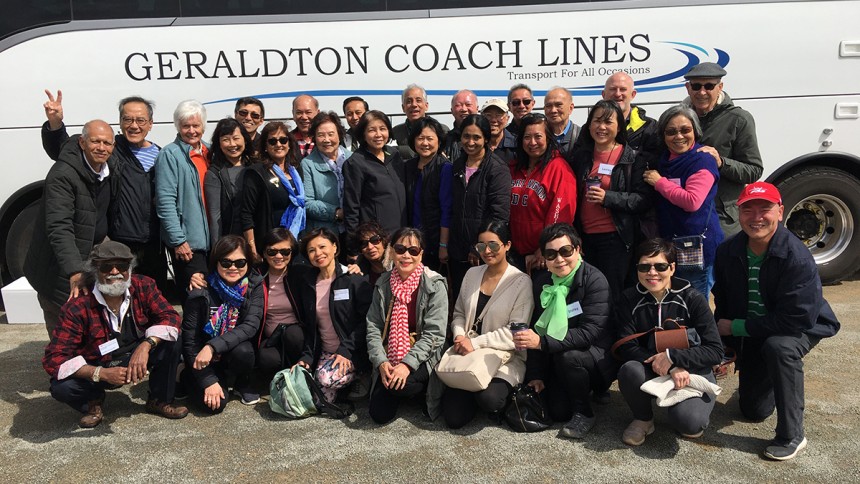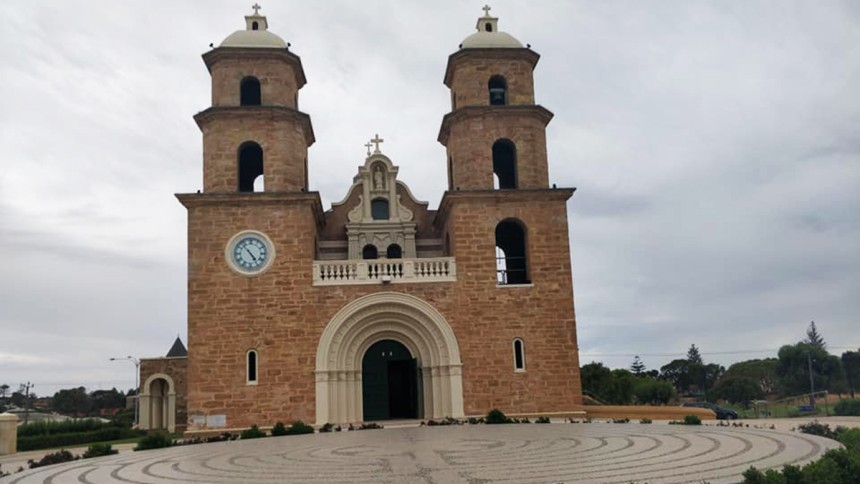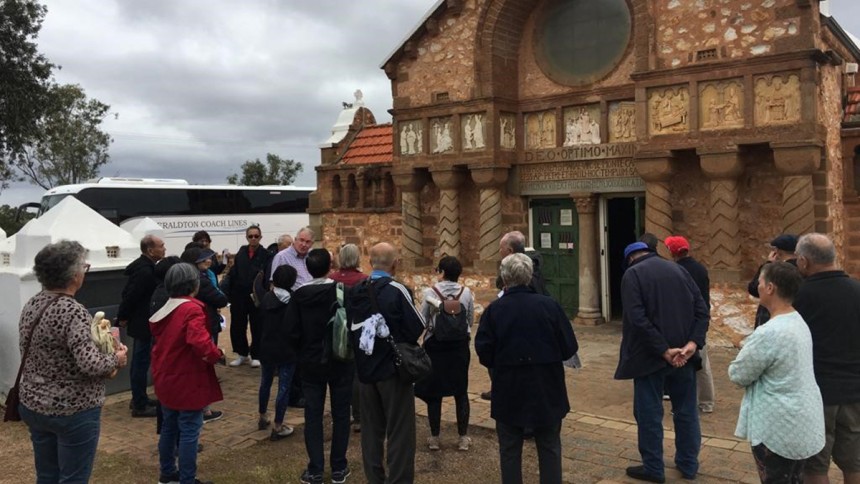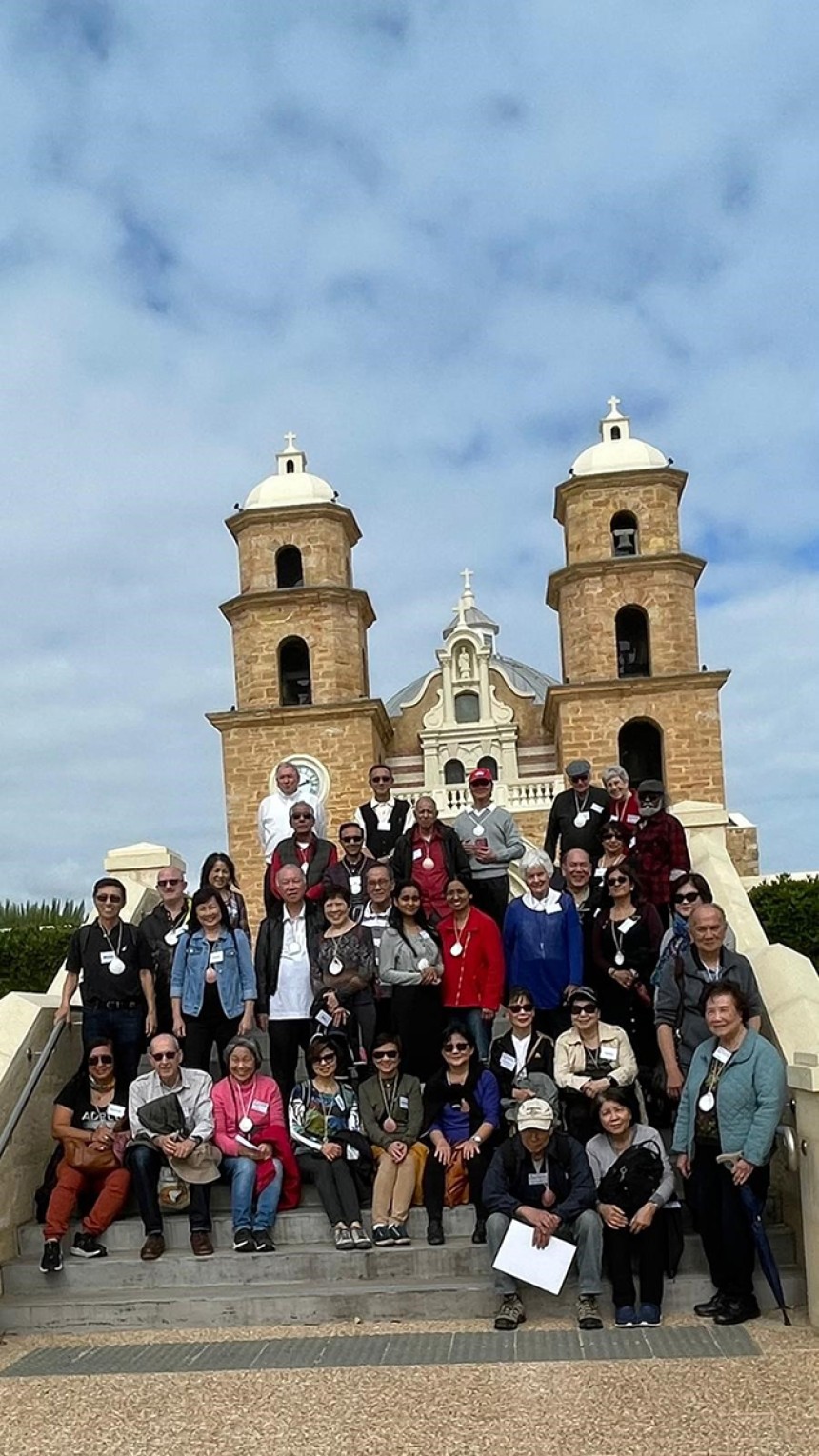Bateman parish pilgrims on a journey at WA’s holy backyard
By Dr Joseph M Fernandez
One day in late August, as Perth winter’s crisp air yielded to the morning sun, 34 pilgrims from Bateman Parish St Thomas More Catholic Church prayed in unison on board a large tourist coach, as it glided through the rush-hour.
Parish Priest Father Phong Nguyen led the prayer, marking the start of the ‘Hawes Heritage Tour’ from 30 August to 2 September 2021.

Companions on the journey: The pilgrims at a lunch stop during the pilgrimage. Photo: Supplied.
They arrived at the first destination – the Mid-West coastal city of Geraldton, 424 km north of Perth at midday.
City administrators extol Greater Geraldton as being “all about the lifestyle!”, having “a beautiful Mediterranean climate” where “the sun shines almost all the time”.[1]
It also hosts the iconic St Francis Xavier (SFX) Cathedral, described by the National Trust as “a major Australian work in the Gothic revival style”.[2]
The Cathedral’s significance extends beyond Australia.

Mullewa rosary procession: Fr Robert Cross leads the pilgrims on a rosary dedicated to Our Lady of Mt Carmel, on a trail leading to the Church of Our Lady of Mt Carmel, Mullewa. Photo: Supplied.

Standing strong a century later: The Our Lady of Mt Carmel Church designed and built between 1923 and 1927. St Michael the Archangel’s wing was added in 1962 to cater for the growing population. It remains the parish church in Mullewa. Photo: Supplied.

Hawes-inspired art works: Fr Robert Cross briefs pilgrims on Mgr Hawes’s intricate artwork depicting the seven Sacraments of the Church, at the entrance to Our Lady of Mt Carmel Church, Mullewa. Photo: Supplied.
It is a landmark building of international importance, and its story has been published worldwide in a book listing 83 magnificent cathedrals from around the world.[3]
The Cathedral was the first, and the main, pilgrimage stop.
Geraldton Diocesan Director of Heritage, Father Robert Cross, laid out a warm welcome, as pilgrims ate lunch and freshened up.
The stop included a visit to the Monsignor Hawes Heritage Centre, in the SFX Cathedral grounds, which enables visitors to understand Hawes’ architecture and art.
That was followed by Fr Cross’s captivating briefing on the Cathedral’s design and history, an exploration of the Cathedral’s ornate décor, and of its nooks and crannies, and a spine-chilling demonstration of the Cathedral’s pipe organs whose enchanting sounds reverberated through the chamber.
The pilgrimage was named after former parish priest Monsignor John Cyril Hawes.
Hawes qualified as an architect in 1897, later becoming an Anglican Deacon in 1903, converting to Catholicism in 1911.
He arrived in Geraldton in 1915 and served as parish priest of Mullewa/Yalgoo.
The Cathedral’s foundation stone was laid the next year and the building completed 22 years later.[4] Hawes went on to receive the papal title ‘Monsignor’ in 1937.[5]
The SFX Cathedral’s electronic bells are among the building’s numerous highlights. It is programmed to play the national anthems of the world’s nations, on the respective national days. Three of the 27 bells swing, including the largest of the bells that weighs just over one tonne.[6]

St Francis Xavier Cathedral, Geraldton: The St Thomas More pilgrims on the steps of the world-famous cathedral, with Fr Robert Cross (top left) and Fr Phong Nguyen (top centre). Photo: Supplied.
Fr Cross, demonstrated an encyclopaedic knowledge of church history, archaeology, and architecture.
He played tour guide throughout the pilgrimage and on one occasion himself drove the pilgrims about in a coach.
The program for the three-day pilgrimage was jam-packed with activity and visits primarily to significant landmarks and icons associated with Monsignor Hawes.
Aside from the St Francis Xavier Cathedral, other stops during the tour included Monsignor Hawes Hermitage (built to serve as Hawes’ retirement abode), the tomb-like cemetery Chapel of San Spirito Utakarra, the Church of Our Lady of Fatima Nanson, the Church of Our Lady of Ara Coeli Northampton (the largest parish church designed by Hawes), and the adjoining Sacred Heart Convent, the Our Lady of Mount Carmel Church in Mullewa, the Priest House Museum, the Pioneer Cemetery, Mass Rock (a natural outcrop of rock on the outskirts of Mullewa to accommodate the mass needs of Indigenous people in the area) and St James chapel (Kojarena).
Sites of touristic interest included the Skywalk in Kalbarri, Pink Lake in Port Gregory, and Pindar’s Wreath Flower phenomenon.
Preparations for the tour began well in advance and included two in-person Saturday briefing sessions and numerous WhatsApp advisories.
The pilgrims were divided into smaller groups allocated to an industrious band of team leaders.
This leadership team was responsible for head counts, attention to minor details such as ensuring adequate distribution of drinking water and snacks during journeys, the recording of meal orders, and attention to personal requests for assistance.
The tour organising group was led by a team of Father Phong’s able lieutenants and their spouses, many of whom were otherwise engaged in various roles in the parish ministries.
The varied pilgrim profile, age-wise (early 20s to the 80s) and agility-wise, was no impediment to team compatibility and mobility.
Songs of praise and worship and non-liturgical songs punctuated the entire journey, on the coach, in places of worship, and in public spaces.
Fr Cross was a master at fostering fellowship, mirth, and merriment.
He and Father Phong presided at Masses and worship interludes at various stops.
By trip’s end pilgrims were thirsting for the next pilgrimage.
The onset of the COVID-19 Pandemic had scuttled everyone’s plans for travel and created a groundswell of desire to break free.
The pilgrimage to a destination within Western Australia presented just the remedy for the travel-starved, and a golden opportunity to discover the rich religious history and heritage on our doorstep.
[1] City of Greater Geraldton. About Greater Geraldton. Retrieved from: https://www.cgg.wa.gov.au/live/my-home/about-greater-geraldton.aspx
[2] National Trust. St Francis Xavier’s Cathedral Conservation Appeal. Retrieved from: https://www.nationaltrust.org.au/st-francis-xaviers-cathedral-conservation-appeal/
[3] Monsignor Hawes Heritage Centre. St Francis Xavier Cathedral Geraldton. Retrieved from: https://www.monsignorhawes.com/sfx-cathedral/
[4] The Organ Society of Western Australia. Western Australian Pipe Organs, St Francis Xavier Cathedral, Geraldton. Retrieved from: http://www.oswa.org.au/sup/WAOrgans/Geraldton/GeraldtonFrancisXavier.html
[5] A. G. Evans. Hawes, John Cyril (1876–1956). Biography. Australian Dictionary of Biography. Retrieved from: https://adb.anu.edu.au/biography/hawes-john-cyril-6601
[6] Diocese of Geraldton. The Geraldton Bells Ring for the First Time. Retrieved from: https://geraldtondiocese.org.au/60-heritage
